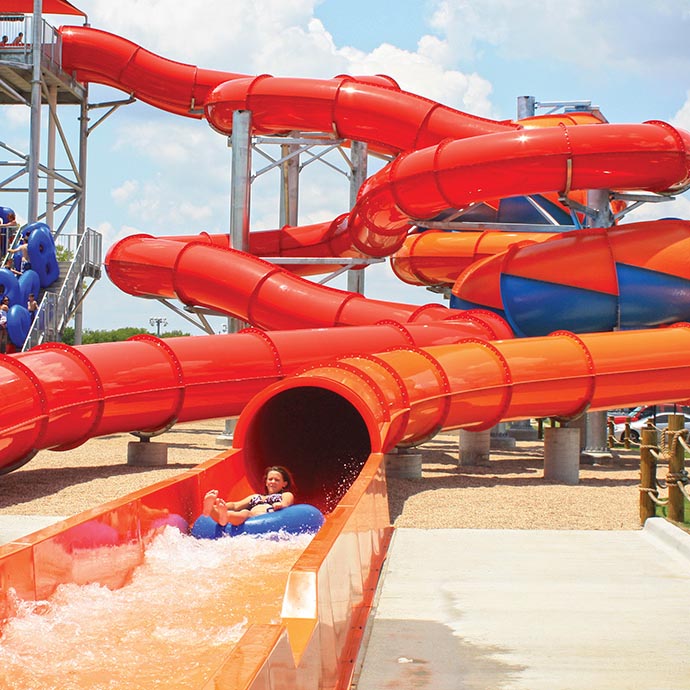10 Maintenance Tips from Waterpark Experts
Many parks operators had to learn maintenance tips and tricks the hard way. Now, they’re passing along their knowledge and wisdom to others on how they keep their waterpark pristine all year long.

1. Roger Skaggs, Maintenance Supervisor, NRH2O Waterpark, Texas
“To avoid changing your gaskets yearly, it’s important to winterize your play structure by draining all the pipes properly. Take the bleed cap off and let the water drain otherwise it will freeze and expand and look for some way out, which will probably be your gasket seal!”
2. Jason Bays, Director of Aquatics, Camelback Lodge & Aquatopia Indoor Waterpark, Pennsylvania
“The first thing any new operator can do is read the operating and maintenance (O&M) manual for their attractions. The O&M manual essentially gives you every secret you need to know on how to properly maintain your equipment. By understanding how the manufacturer wants you to properly maintain a ride or attraction, you are less likely to make mistakes.”
3. Pat Finnegan, previous Director of Operations, Wet’n Wild Orlando and General Manager, Chula Vista Resort Wisconsin Dells
“Put your equipment away properly at the end of the season. Poor seasonal shutdown can cost significant time and money in the spring when you realize you have to get things repaired, replaced and/or cleaned. If you had just put your equipment away properly, that all could have been avoided!”
4. Anthony Sabo, Rides Maintenance Manager, Columbus Zoo and Aquarium, Ohio
“Don’t be afraid of change and always challenge the status quo! For example, we overcame an issue with our pool chemistry by looking into alternatives that actually made our pool chemistry easier to maintain and was safer for our guests and our staff and reduced costs by 9%.”
5. Vince Cuilla, Director, Maintenance & Construction, Six Flags America & Hurricane Harbor, Maryland
“We employ measures that allow us to be pro-active vs. reactive with our maintenance. For example, we use vibration analysis/predictive maintenance on all of our pumps and motors. This provides early problem detection, allowing time for sourcing components while minimizing downtime.”
6. Roger Skaggs, Maintenance Supervisor, NRH2O Waterpark, Texas
“Waxing the fiberglass waterslide flume before and after the season is essential to lessen UV breakdown and to keep your waterslide’s riding path smooth and slick all season long.”
7. Jason Bays, Director of Aquatics, Camelback Lodge & Aquatopia Indoor Waterpark, Pennsylvania
“Plan ahead! A preventative maintenance program is only effective when you have a schedule of tasks and plan on when to complete them. Put together a schedule of projects to complete and ensure you have action items of things which need to be completed to hit the target date of any maintenance project. By putting together a schedule which includes details of ordering parts, organizing labor and man hours, and planning out important dates, it allows one to stay organized and ensure nothing is missed.”
8. Chris Perry, previous General Manager, Wild Wadi Waterparks, Dubai
“Save time by labeling your waterslide joints. Often the person walking the slide is not necessarily going to be the person repairing the slide. By labeling the joints, it makes it extremely easy to identify, log and communicate the exact location of any issues.”
9. Ron Sutula, GM, Schlitterbahn Galveston Island, Texas
“When performing maintenance (i.e. sanding, grinding, or cutting) of steel adjacent to waterslides, cover the slides to prevent metal filings from coming in contact with the slides and clean daily.
If you don’t cover and clean and the filings become wet, or even damp from dew, they will rust and permeate the slides gel coat, which will lead to additional maintenance.”
10. Jason Bays, Director of Aquatics, Camelback Lodge & Aquatopia Indoor Waterpark, Pennsylvania
“Checklists are your friend! The details are important and you can’t possibly remember everything on your own. When performing maintenance, keep a log of the details of what you are doing. You will be amazed how helpful that information will be when you go to perform the same task in the future.”




Leave a Reply
You must be logged in to post a comment.